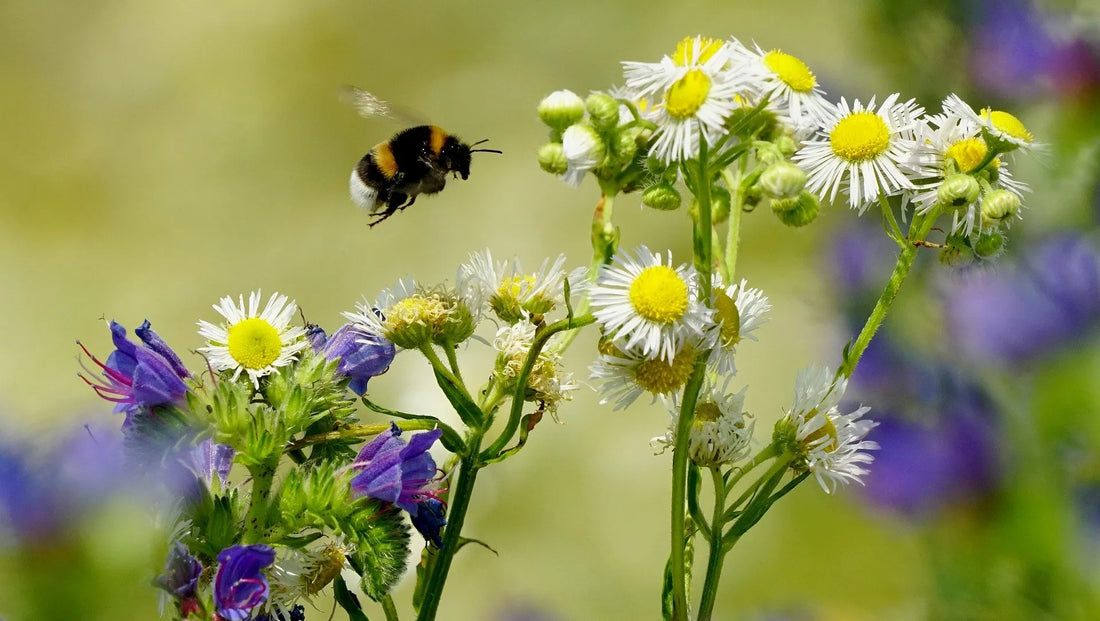We often get asked if bumblebees (or different types of bees) sting or want to sting us.
This fear of bees comes from the fact that bees have stingers. Surprisingly though, not all bees have them. The male bees (in any species) cannot sting as they don't have the stinging anatomy, which makes them super safe. These 'drones' are much bigger than their female counterparts and have a rounded bottom. Their role is to reproduce with a fertile Queen and they don't collect pollen or nectar.A Wasp or a Bee?
Like bees, wasps live in colonies and pollinate our world, but they look different to bees. They have much more vivid yellow and black banding around their abdomen and have yellow legs.
Now, let's look at the 3 top types of female bees you will come across to understand why bees sting and any risks involved:
1) The Humble Honeybee

Honeybees are known as 'social' insects as they live in hives with other bees. Their abdomens are larger than their heads and are either black or brown with bits of yellow.
Do honeybees sting?
Yes, female honeybees do have stingers and they are the only bees that die straight after stinging. This is because they have barbed stingers that hook into the skin, which takes the bee's digestive tract, nerves and muscles with it when it pulls away.
But honeybees (or any bees) do not want to sting you.
So why do bees sting?
Bees sting if you appear as a threat and their only option is to sacrifice themselves to protect the colony. As the entomologist, Emily Sadler states, bees who are seeking pollen and nectar are unlikely to sting because fleeing is easier. Fighting a possible threat takes time and energy she could be putting into foraging, and, for honeybees, death is a sure fact after stinging.
2) Bumble Bees - The Fuzziest of Them All

Bumblebees are another kind of 'social' bee that live together in nests. They have hairy, black bodies with varying yellow banding and have much bigger, ¾ inch bodies and a more rounded abdomen than honeybees.
Do bumblebees sting you?
Their female workers and queens do have stingers, but unlike honeybees, if they sting, they won't die. This is because bumblebees have no barbs that get stuck in the skin and can remove the stinger completely.
Yet, bumblebees rarely sting as they are not aggressive. Unless you are threatening or swatting one near you, you are unlikely to get stung as the RSPB instructs us.
3) The Lone Wolves

Solitary bees don't live in hives and, after finding a mate, she works alone to lay her eggs (up to 20 to 30 during her life!) and forages for nectar and pollen. These bees can be found in underground burrows or dead wood.
There are many types of solitary bees, but the top 3 solitary bees you will find are the leafcutter bee (with a broad head and large mandibles), the red mason bee (with red/gingery hair and little horns on their heads), and the wool carder bee (with vivid yellow and black stripes on a flattened body).
Solitary Bees are non-Aggressive
But do solitary bees sting?
You should never make any bee feel threatened as they could sting, but due to the solitary bee's passive nature, even if she is threatened, the entomologist Sadler tells us that she is far more likely to prioritise laying new eggs than risk her energy and time on you.
Since they live to forage for food and nesting materials for their young, solitary bees are non-aggressive and do not swarm. They are safe around children and bee stings on dogs or other pets are rare as they aren't interested in us. To avoid getting stung, move slowly away from an area instead of swatting a bee and always wear shoes outside to prevent a bee sting on your foot.
Remember that even wasps, who are more determined to check out our food than our fuzzy bee friends, aren't out to attack anyone. Insects will only sting to protect their colonies. Justin Schmidt, an entomologist who created the Schmidt Sting Pain Index, said it was hard to get even a mud dauber wasp to sting him as it took 3-4 tries of heavy handling.
Saving the Bees
Bees complete 80% of all pollination across the world and are crucial to our crops and farming. We have 270 species of bee in the UK and about 250 of these are solitary bees.
Solitary bees are better pollinators than the other species of bee. For example, one red mason bee can do the pollination job of 120 honeybee workers! This is because they don't carry pollen baskets and end up spilling their pollen and pollinating flowers as they go.
But sadly, these solitary bees are the most at risk as their loss of habitat is their biggest killer (as well as the use of increased pesticides, pathogens and climate change.) It is crucial to protect these bees by providing spaces like bee hotels so they can lay their eggs. You can also plant bee-friendly flowers to help them help us while they continue pollinating planet earth.



1 comment
Very helpful and informative.